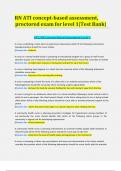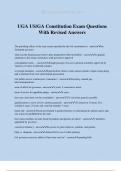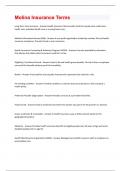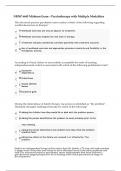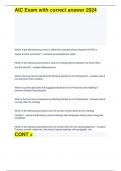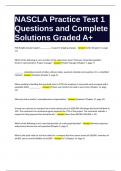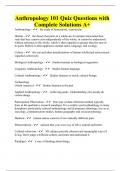1. AS Macro – The Measurement of Macroeconomic
Performance
Government Objectives
• Balance of payments on current account (exports and imports)
• Economic growth – GDP is the total amount of goods and services produced by an
economy in a year
• Stable inflation (inflation = rise of price levels, when money starts to lose value, 2%
target in the UK)
• Low unemployment
Conflict can arise from trying to achieve different objectives:
• These objectives can’t necessarily be achieved at the same time
• Policies taken to achieve one might disrupt others, e.g. for spending to increase
employment levels may lead to higher inflation
Index Number
• Used to make comparisons over time
• The key idea is that all subsequent data points can be compared back to an initial
‘base’
• The base is always shown with an index of 100
• Index = (price value of year X / value of base year) x 100
1
,2. AS Macro - How the Macroeconomy Works: The Circular Flow of
Income, Aggregate Demand/Aggregate Supply, and Related
Concepts
Ways of measuring the level of economic activity:
• National output (O) – value of goods and services to and from households
• National expenditure (E) – value of spending by households on goods and services
• National income (Y) - value of income paid by firms to households in return for
factors
O≡E≡Y
The Circular Flow of Income
Withdrawals (W) (leakages):
• Only part of income received by households will be spent on the goods and services
of domestic firms. The rest are withdrawn from the flow (W). Only part of income
generated by firms will be paid to households…the rest will be withdrawn.
Types of withdrawals:
• Savings (S)
1
, • Taxes (T) – when people pay taxes they are withdrawn from the system, however
when the government then pays benefits to households this is then an injection (J).
These benefits are known as transfer payments
• Imports (M)
W=S+T+M
Injections (J):
• These represent spending on domestic goods and services coming from outside the
inner circular flow
Types of injections:
• Investment (I)
• Government expenditure (G)
• Exports (X)
J=I+G+X
• If injections = withdrawals, then the circular flow is in balance (S + T + M = I + G + X)
• If I + G + X > S + T + M then national income will rise
• If I + G + X < S + T + M then national income will fall
Nominal and real income:
• Nominal income measures income at current prices with no adjustment for the
effects of inflation
• Real income refers to the income of an individual or group after taking into
consideration the effects of inflation on purchasing power
Aggregate Demand and Aggregate Supply
Aggregate demand:
• Definition – The total spending on goods and services made within a country, i.e.
domestically produced
AD = C + I + G + (X-M)
• C = consumption
• I = investment
• G = government
• X = export
• M = import
2
, The AD curve:
Reasons for the AD curve sloping downwards:
• As the price level rises, real wealth falls
• As the price level rises, domestic products become less competitive. Exports fell and
imports rise, X-M gets worse
• As the price level rises, interest rate also tends to rise
Summary:
• Prices in economy increase = increased demand for money = increase in interest
rates = fall in consumption and investment = fall in aggregate expenditure = fall in
national income = fall in output
3
Performance
Government Objectives
• Balance of payments on current account (exports and imports)
• Economic growth – GDP is the total amount of goods and services produced by an
economy in a year
• Stable inflation (inflation = rise of price levels, when money starts to lose value, 2%
target in the UK)
• Low unemployment
Conflict can arise from trying to achieve different objectives:
• These objectives can’t necessarily be achieved at the same time
• Policies taken to achieve one might disrupt others, e.g. for spending to increase
employment levels may lead to higher inflation
Index Number
• Used to make comparisons over time
• The key idea is that all subsequent data points can be compared back to an initial
‘base’
• The base is always shown with an index of 100
• Index = (price value of year X / value of base year) x 100
1
,2. AS Macro - How the Macroeconomy Works: The Circular Flow of
Income, Aggregate Demand/Aggregate Supply, and Related
Concepts
Ways of measuring the level of economic activity:
• National output (O) – value of goods and services to and from households
• National expenditure (E) – value of spending by households on goods and services
• National income (Y) - value of income paid by firms to households in return for
factors
O≡E≡Y
The Circular Flow of Income
Withdrawals (W) (leakages):
• Only part of income received by households will be spent on the goods and services
of domestic firms. The rest are withdrawn from the flow (W). Only part of income
generated by firms will be paid to households…the rest will be withdrawn.
Types of withdrawals:
• Savings (S)
1
, • Taxes (T) – when people pay taxes they are withdrawn from the system, however
when the government then pays benefits to households this is then an injection (J).
These benefits are known as transfer payments
• Imports (M)
W=S+T+M
Injections (J):
• These represent spending on domestic goods and services coming from outside the
inner circular flow
Types of injections:
• Investment (I)
• Government expenditure (G)
• Exports (X)
J=I+G+X
• If injections = withdrawals, then the circular flow is in balance (S + T + M = I + G + X)
• If I + G + X > S + T + M then national income will rise
• If I + G + X < S + T + M then national income will fall
Nominal and real income:
• Nominal income measures income at current prices with no adjustment for the
effects of inflation
• Real income refers to the income of an individual or group after taking into
consideration the effects of inflation on purchasing power
Aggregate Demand and Aggregate Supply
Aggregate demand:
• Definition – The total spending on goods and services made within a country, i.e.
domestically produced
AD = C + I + G + (X-M)
• C = consumption
• I = investment
• G = government
• X = export
• M = import
2
, The AD curve:
Reasons for the AD curve sloping downwards:
• As the price level rises, real wealth falls
• As the price level rises, domestic products become less competitive. Exports fell and
imports rise, X-M gets worse
• As the price level rises, interest rate also tends to rise
Summary:
• Prices in economy increase = increased demand for money = increase in interest
rates = fall in consumption and investment = fall in aggregate expenditure = fall in
national income = fall in output
3


